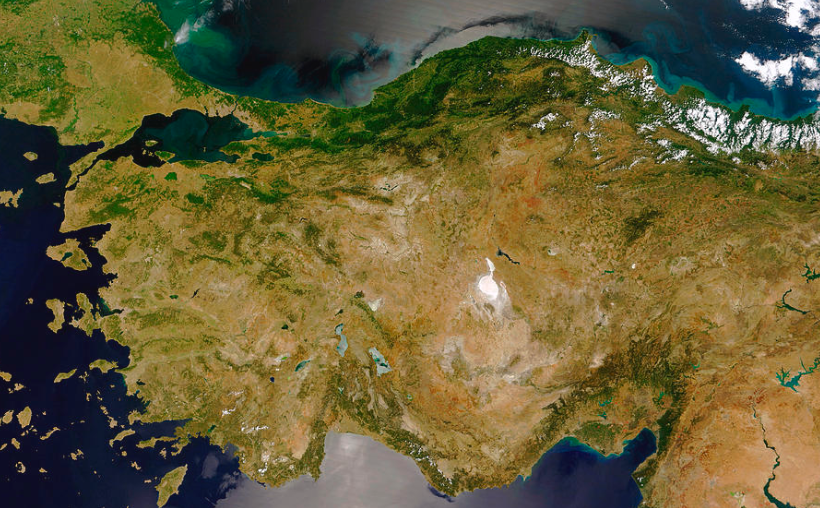Anatolia (from Greek: Ἀνατολή, Anatolḗ, “east” or “[sun]rise”; Turkish: Anadolu), also known as Asia Minor (Medieval and Modern Greek: Μικρά Ἀσία, Mikrá Asía, “small Asia”; Turkish: Küçük Asya), Asian Turkey, the Anatolian peninsula or the Anatolian plateau, is a large peninsula in West Asia and the westernmost protrusion of the Asian continent. It makes up the majority of modern-day Turkey. The region is bounded by the Black Sea to the north, the Mediterranean Sea to the south, the Armenian Highlands to the east and the Aegean Sea to the west. The Sea of Marmara forms a connection between the Black and Aegean seas through the Bosphorus and Dardanelles straits and separates Anatolia from Thrace on the Balkan peninsula of Europe.
The eastern border of Anatolia is traditionally held to be a line between the Gulf of Alexandretta and the Black Sea, bounded by the Armenian Highland to the east and Mesopotamia to the southeast. Thus, traditionally Anatolia is the territory that comprises approximately the western two-thirds of the Asian part of Turkey. Today, Anatolia is also often considered to be synonymous with Asian Turkey, which comprises almost the entire country;[5] its eastern and southeastern borders are widely taken to be Turkey’s eastern border.[6] By some definitions, the Armenian Highlands lies beyond the boundary of the Anatolian plateau. The official name of this inland region is the Eastern Anatolia Region.[7][8]
The ancient inhabitants of Anatolia spoke the now-extinct Anatolian languages, which were largely replaced by the Greek language starting from classical antiquity and during the Hellenistic, Roman and Byzantine periods. Major Anatolian languages included Hittite, Luwian, and Lydian, among other more poorly attested relatives. The Turkification of Anatolia began under the Seljuk Empire in the late 11th century and continued under the Ottoman Empire between the late 13th and early 20th centuries. However, various non-Turkic languages continue to be spoken by minorities in Anatolia today, including Kurdish, Neo-Aramaic, Armenian, Arabic, Laz, Georgian and Greek. Other ancient peoples in the region included Galatians, Hurrians, Assyrians, Hattians, Cimmerians, as well as Ionian, Dorian and Aeolian Greeks.
Traditionally, Anatolia is considered to extend in the east to an indefinite line running from the Gulf of Alexandretta to the Black Sea,[9] coterminous with the Anatolian Plateau. This traditional geographical definition is used, for example, in the latest edition of Merriam-Webster’s Geographical Dictionary.[1] Under this definition, Anatolia is bounded to the east by the Armenian Highlands, and the Euphrates before that river bends to the southeast to enter Mesopotamia.[2] To the southeast, it is bounded by the ranges that separate it from the Orontes valley in Syria (region) and the Mesopotamian plain.[2]
Following the Armenian genocide, Ottoman Armenia was renamed “Eastern Anatolia” by the newly established Turkish government.[10][11] Vazken Davidian terms the expanded use of “Anatolia” to apply to territory formerly referred to as Armenia an “ahistorical imposition”, and notes that a growing body of literature is uncomfortable with referring to the Ottoman East as “Eastern Anatolia”.[12] Most archeological sources consider the boundary of Anatolia to be Turkey’s eastern border.[13]
The highest mountains in “Eastern Anatolia” (in Armenian Plateau) are Mount Süphan (4058 m) and Mount Ararat (5123 m).[14] The Euphrates, Araxes, Karasu and Murat rivers connect the Armenian plateau to the South Caucasus and the Upper Euphrates Valley. Along with the Çoruh, these rivers are the longest in “Eastern Anatolia”.[15]
The oldest known reference to Anatolia – as “Land of the Hatti” – appears on Mesopotamian cuneiform tablets from the period of the Akkadian Empire (2350–2150 BC).[citation needed] The first recorded name the Greeks used for the Anatolian peninsula, though not particularly popular at the time, was Ἀσία (Asía),[20] perhaps from an Akkadian expression for the “sunrise”, or possibly echoing the name of the Assuwa league in western Anatolia.[citation needed] The Romans used it as the name of their province, comprising the ancient landscapes to the west of the peninsula plus the adhering islands of the Aegean. As the name “Asia” broadened its scope to apply to the vaster region east of the Mediterranean, some Greeks in Late Antiquity came to use the name Μικρὰ Ἀσία (Mikrà Asía) or Asia Minor, meaning “Lesser Asia” to refer to present-day Anatolia, whereas the administration of the Empire preferred the description as Ἀνατολή (Anatolḗ “the East”).
The endonym Ῥωμανία (Rhōmanía “the land of the Romans, i. e. the Eastern Roman Empire”) was understood as another name for the province by the invading Seljuq Turks, who founded a Sultanate of Rûm in 1077. Thus “(land of the) Rûm” became another name for Anatolia. By the 12th century Europeans had started referring to Anatolia as Turchia.[21]
During the era of the Ottoman Empire mapmakers outside the Empire referred to the mountainous plateau in eastern Anatolia as Armenia. Other contemporary sources called the same area Kurdistan.[22] Geographers have variously used the terms east Anatolian plateau and Armenian plateau to refer to the region, although the territory encompassed by each term largely overlaps with the other. According to archaeologist Lori Khatchadourian this difference in terminology “primarily result[s] from the shifting political fortunes and cultural trajectories of the region since the nineteenth century.”[13]
Turkey’s First Geography Congress in 1941 created two regions to the east of the Gulf of Iskenderun-Black Sea line named the Eastern Anatolia Region and the Southeastern Anatolia Region,[23] the former largely corresponding to the western part of the Armenian Highland, the latter to the northern part of the Mesopotamian plain. According to Richard Hovannisian this changing of toponyms was “necessary to obscure all evidence” of Armenian presence as part of a campaign of genocide denial embarked upon by the newly established Turkish government and what Hovannisian calls its “foreign collaborators”.[24]
